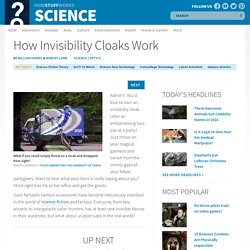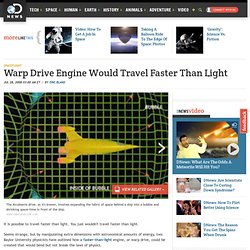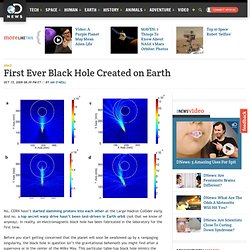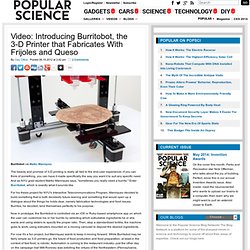

'Invisibility Cloak' Directs Light Away From Eye : Discovery News. Admit it.

You'd love to own an invisibility cloak. Utter an embarrassing faux pas at a party? Just throw on your magical garment and vanish from the snooty gaze of your fellow partygoers. Want to hear what your boss is really saying about you? Stroll right into his or her office and get the goods. Such fantastic fashion accessories have become ridiculously standard in the world of science fiction and fantasy.
Warp Drive Engine Would Travel Faster Than Light. It is possible to travel faster than light.

You just wouldn't travel faster than light. Seems strange, but by manipulating extra dimensions with astronomical amounts of energy, two Baylor University physicists have outlined how a faster-than-light engine, or warp drive, could be created that would bend but not break the laws of physics. "We think we can create an effective warp drive, based on general relatively and string theory," said Gerald Cleaver, coauthor of the paper that recently appeared on the preprint server ArXiv.org The warp engine is based on a design first proposed in1994 by Michael Alcubierre. The Alcubierre drive, as it's known, involves expanding the fabric of space behind a ship into a bubble and shrinking space-time in front of the ship. The tricky part is that the ship wouldn't actually move; space itself would move underneath the stationary spacecraft.
Warp Drive Engine Could Suck Earth Into Black Hole. First Ever Black Hole Created on Earth. No, CERN hasn’t started slamming protons into each other at the Large Hadron Collider early.

And no, a top secret warp drive hasn’t been test-driven in Earth orbit (not that we know of anyway). In reality, an electromagnetic black hole has been fabricated in the laboratory for the first time. Before you start getting concerned that the planet will soon be swallowed up by a rampaging singularity, the black hole in question isn’t the gravitational behemoth you might find after a supernova or in the center of the Milky Way.
This particular table-top black hole mimics the curvature of space-time, creating a fabricated event horizon that swallows electromagnetic radiation at microwave wavelengths. The best thing is that this experiment isn’t just for curiosity-sake, it has a practical application that could revolutionize future solar panel design, making the production of solar energy a lot more efficient than it is currently. Exovolt stackable battery creates unlimited capacity. Don't have enough spare juice to charge all your iThings?

The Exovolt Plus is a stackable battery pack with unlimited expandable capacity, according to maker Exogear. The charger consists of a main 5,200 mAh lithium polymer battery and sub batteries that you can pile underneath it to create a battery stack. Each unit is 3.7 inches square and weighs about 5.5 ounces. It comes with 30-pin and micro-USB connectors and can charge Apple iPhones, iPads, and iPods, as well as most smartphones and tabs. The four LED lights on the units show how much power remains. The main battery will sell for $89.95 and the sub batteries for $49.95.
Physicists Demonstrate Working Quantum Router, a Step Toward a Quantum Internet. Electric Spray Paint Could Turn Any Surface Into a Battery. Five Reasons Why I'm Excited About Google's Nexus Q. Stanford's New Electrojelly Feels Like Living Tissue, But Acts Like a Semiconductor. Future electronic skin and bio-batteries could be etched onto surfaces with inkjet printers, conducting electricity while looking for all the world like spongy biological tissue.
A new electrically conductive hydrogel, developed at Stanford University, can be printed or sprayed as a liquid and turned into a gel once it's in place. Hydrogels are semi-solid gummy-bear-like materials, made up of chains of water-avoiding polymer molecules. Their hydrophilic properties make them good analogues for biological tissue, because like living tissue, they are soft, flexible and semi-porous. This new hydrogel is made of organic compounds, including one found in plant tissues, which cross-link into complex networks. Other conductive hydrogels are made by connecting conductive materials inside a non-conductive, insulating matrix, which reduces the overall material's ability to carry a current. A Heatsink That Could Be 30 Times More Efficient Than Today's Setups. Computers get hot.

Heat is bad for computers. To whisk it away, we use a combination of heatsinks and fans to snatch heat away from the internals and blast it out of the computer's case. Video: Introducing Burritobot, the 3-D Printer that Fabricates With Frijoles and Queso. The beauty and promise of 3-D printing is really all tied to the end-user experience--if you can think of something, you can have it made specifically the way you want it to suit any specific need.

And as NYU grad student Marko Manriquez says, "sometimes you really need a burrito. " Enter Burritobot, which is exactly what it sounds like. For his thesis project for NYU's Interactive Telecommunications Program, Manriquez decided to build something that is both decidedly future-leaning and something that would open up a dialogue about the things he holds dear, namely fabrication technologies and food issues. Burritos, he decided, lend themselves perfectly to his purpose.